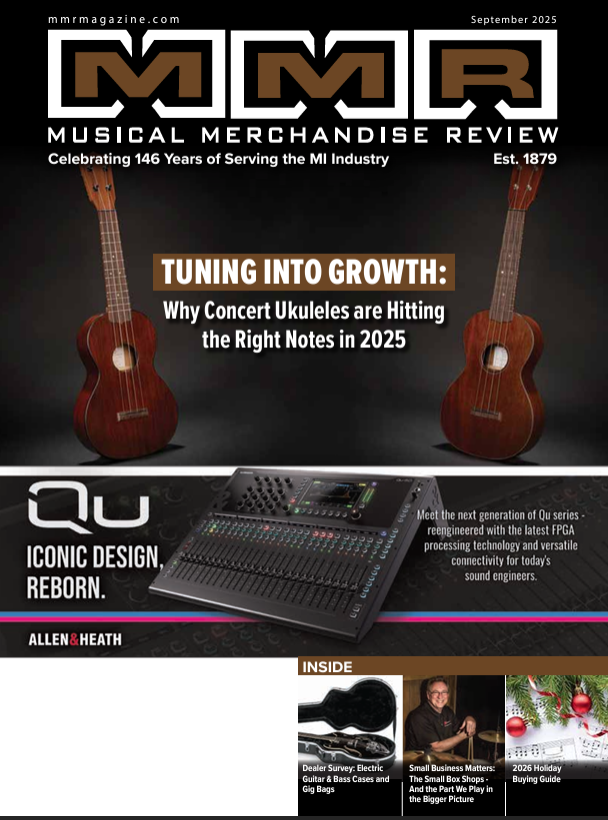
In 1965 Country artist Roger Miller wrote and performed “England Swings (Like A Pendulum Do).” I can’t help but wonder what Miller would say about the music retail and education pendulums that are currently swinging. What would he say about the way they will swing as we continue into 2021 and beyond?
We are wise to remember the pendulum always returns to center
Whether it’s supply and demand, or sales trends in general, spikes and dips even out over time. And, as they say in the world of finance, “Let the market settle the argument.” For some music stores, especially the online retailers, this past year has been buoyant and unexpectedly productive. The surge in guitar sales brought on by “COVID isolation blues” has been an unexpected boon, and that boon has helped balance out the madness and interruption to our current social norm.
It has also created a shortage of supply and a scarcity of products, and that exact same trend happened in the world of bike shops as well. So, what does this tell us, and how do we read those tea leaves? Perhaps the tea leaves tell us that this past year rudely reminded us that putting off our personal growth until tomorrow is not a fulfilling practice – and that practice is no longer acceptable.
Let’s try predicting the pendulum for in-person education
Remember vinyl? Remember how hard you laughed when you heard the rumor that vinyl was going to make a comeback? Don’t ya just hate it when you’re wrong? My point is that we will see a pent-up demand for in-person lessons. Actually, we are already starting to see the signs of that trend now.
The rekindled appetite for in-person music lessons vs. virtual lessons
How many Zoom calls did you log onto this week? It’s fair to say the burn-out factor for Zoom is extraordinarily high. People are “Zoom-exhausted” and rightfully so. We have been dealing with the COVID-19 virtual madness for one full year. Everyone can really feel the frustration rising, and the tide slowly turning toward human interaction with every new phone call.
The reason for that is simple: people want and need human interaction when learning; virtual tools only carry you so far. Think about it. People buy a wonderful new instrument because they have a rekindled passion to do something that they have put off forever, and now they have different options when they begin learning how to play the instrument:
They can watch a non-interactive YouTube video and try to mimic what they are watching. That approach is questionable as there is the risk of inconsistent information being presented and no opportunity to inner act.
The students can have a friend show them how to play, and that’s fun for a while, but the odds of success are not a guarantee.
They can join a subscription site, but still there is no true in-person human connection, and little chance for the development of a deep rapport.
The students can also find a reputable, qualified local teacher, and perhaps keep our hand in some online support. Bingo! This is clearly the best chance for success.
Please don’t misconstrue what I’m saying. Zoom is now part of the “new way,” and there is no going back, nor should we. Zoom-style communications are here to stay. That genie is not going back in the bottle. However, virtual classrooms do expose the weaknesses inherent to online learning and remind us of the basic human need and benefits of in-person learning. There is no denying that.
One trend on the rise in the Zoom, public school classroom is “Zoom pranking” of teachers by those rascally students. Remember, these youths were born into this arena; the teachers, for the most part, are immigrants to the virtual environment. Therefore, oftentimes, the students are the teachers. The Wall Street Journal reported about one very creative but cruel prank. A Zoom class of students agreed (on cue) to turn off their cameras while simultaneously changing their screen names to “reconnecting.” You can find this gem on YouTube. I have no doubt the student who masterminded this coup could easily have been a creative, young musician!
Looking forward, what might we expect?
I might bet on the correction of the pendulum swing. And the best way to benefit from the next trend is to get in early. Currently, the most frequently asked question by someone seeking music education is, “Do you guys teach in-person lessons?” The second question is, “Do you also teach online?” Hopefully, we will see this trend continue. This proper blend of both will bring music educators and entrepreneurs into the winner’s circle. I see great value in the wide acceptance of virtual and video, but there is no true substitute for in- person learning. This may be due in part to the energy that manifests between people when they are together. This also would include the in-person, sonic impulses and sounds of the instrument during the lesson.
Make no mistake, though: the rekindled acceptance of video and virtual is helpful as educators and owners reach out to students just entering school programs. Recently, I received a call to participate in a recruitment video for regional school music programs. Every music program in every school district across the country has been eviscerated during the recent year’s events. What better way to communicate the joy of music-making than a video of musicians and directors having fun together playing and speaking on the benefits of school music programs and the joy of making music!
The good news is with the acceptance of video and virtual in the role of education, school directors might be more apt to ask local music educators to help them revive student enrollment and help them rekindle their school programs.
Seriously, how about that? The pendulum does swing both ways and always does come back to center.

Menzie Pittman is the owner and director of education at Contemporary Music Center in Virginia (CMC). Following a performance and teaching career spanning more than 32 years, he founded CMC in 1989 and continues to perform, teach, and oversee daily operations. He has 50 years of musical experience as a drummer and drum instructor. Menzie is a frequent speaker at NAMM’s Idea Center, and a freelance writer for MMR’s “Small Business Matters”.



























